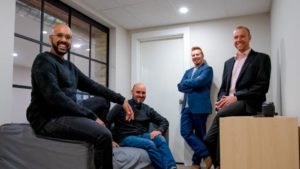Putting 5G to the test
Bringing together business, institutional and technology interests, a new research project begins to utilize Western’s new 5G capabilities
THE LUANCH OF a smart, 5G-connected research centre at Western University is bringing together cutting-edge technology with research aimed at helping students thrive during their time at university.
In partnership with Bell, Western is the first university in Canada testing 5G capability using 3.5 GHz 5G spectrum in pre-commercial mode. It is the beginning of a $2.7-million project to deploy 5G network infrastructure throughout the Western campus. The first 5G site on campus is designated for research now, but by summer a full network is expected to be available across campus.
Kevin Shoemaker, acting associate vice-president (research) and professor of kinesiology, is leading one new research project, along with partners at London-based EXAR Studios, that will utilize the speed, responsiveness and edge computing processing capabilities of the 5G network to develop an app designed to gauge and guide student mental wellness. The app uses biofeedback, such as a visual representation of the user’s heartbeat, to help them learn mindfulness and relaxation skills such as deep breathing to manage anxiety and stress.
“This is a really big deal. The potential for this to turn into something very impactful with our industry partners is exciting from a research perspective” ―Kevin Shoemaker
This biofeedback is conveyed through an augmented reality (AR) program which produces visualization schemes of changes in the heart rate that inform the user about the success of their mindfulness or breathing activities.
“As a very simplistic example, imagine engaging in a breathing exercise and the success of that exercise on your stress levels can be viewed on your phone as being able to move a butterfly from flying in a breeze to safely resting on a leaf,” says Shoemaker.
Story Continues Below
The visualization and gamification features are improved in real-time through the 5G network, making the new Bell-Western 5G Research Centre the only place in Canada where this device can be developed to its full potential.
Shoemaker and his research team will collaborate with Western Student Experience and the Parr Centre for Thriving to refine the app and incorporate it into their student supports. While users will consent to have the information generated by the app collected and analyzed by Western researchers, this will be done anonymously and no personal or phone data will be accessed or shared.
“The 5G network allows us to assess large volumes of data to detect patterns and anomalies among hundreds of variables affecting student mental health,” Shoemaker says. “What we learn can be used to generate interactive feedback between the app and user ― messages that would allow students to take better control of their mental health during stressful times or to flag potential crises.”
 Photo: Kevin Shoemaker, Western University acting associate vice-president (research) and professor of kinesiology
Photo: Kevin Shoemaker, Western University acting associate vice-president (research) and professor of kinesiology
Once rolled out for first-year Western students, the product could be made accessible to other institutions or adapted for other groups and configured as a personal treatment model or as a research device.
“I see so much potential here for Western,” said Jennifer Massey, associate vice-president (Student Experience). “This technology helps us accomplish one of our key priorities, which is to integrate research into how we deliver the most effective student supports. This collaboration between Kevin’s research team, Bell, EXAR Studios and Student Experience can really bring tangible benefits to our students.”
EXAR Studios, which specializes in developing augmented reality technology aimed at advancing smarter cities and enhancing human well-being, is a key partner in this initiative.
“Working together with Bell and Western to find innovative ways to address student mental health using augmented reality technology aligns with our commitment to innovation for community thriving. We’re very excited about the future benefits that will be realized through this collaboration,” notes Ben Switzer, chief growth officer at EXAR Studios.
Shoemaker adds that Western Research has made it a priority to integrate more students into a meaningful research experience and this is one way to make that happen while allowing students to work with new and innovative technologies.
Story Continues Below
From Bell’s perspective, the idea of moving from installation of the network to research and practical applications is where the real progress begins.
“We are excited to partner with Western on building a 5G smart campus hub and research centre,” says Nauby Jacob, senior vice president at Bell Mobility. “This new partnership will engage students, faculty and local start-ups like EXAR to achieve innovative and ground-breaking new research.”
Shoemaker has been working with Bell and an advisory committee to guide research that can be optimized using 5G technologies. He anticipates this will bring a host of data research projects to life in areas such as enhanced smart-city capabilities, improved robotics in surgery and manufacturing and smarter, more reliable autonomous vehicles.
“Ultimately, it’s about better communication ― connecting people, infrastructure, research, business and community,” said Shoemaker. “This is a really big deal. The potential for this to turn into something very impactful with our industry partners is exciting from a research perspective.”
 Photo: Exar Studios’ Shishir Pande, Edward Platero, Daniel Kharlas and Ben Switzer
Photo: Exar Studios’ Shishir Pande, Edward Platero, Daniel Kharlas and Ben Switzer
“Its use at a research-focused university makes it much more important than just beefed-up cell service,” says computer science professor Michal Bauer, who is providing key support for Western’s 5G initiative. “5G brings a number of enhanced technologies. It provides better bandwidth – how fast data can move from one system to another – and the responsiveness and predictable experience of the network allows reliable application performance, which definitely helps in research and user experience.”
Shoemaker is also eager to see sustainability improvements borne out of the technology. Western’s size makes it ideal for correlating minute-by-minute assessments of a building’s energy and water consumption with data about weather, time of day, traffic patterns and dozens of other variables.
“You could actually think about what Western looks like from a smart-city perspective,” Shoemaker sums up, “envisioning not just the way we operate on campus but how a city of our size might operate in a truly integrated way for the benefit of its citizens.” ![]() Story supplied by Western Communications
Story supplied by Western Communications

